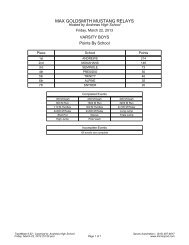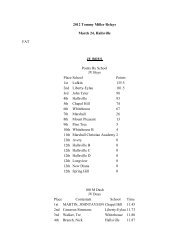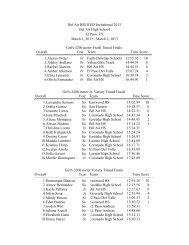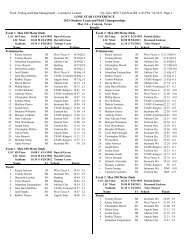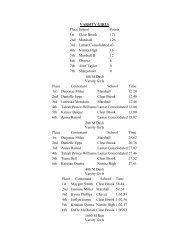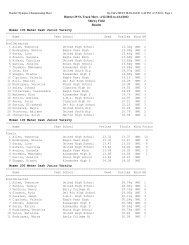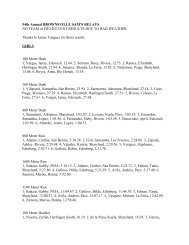1. PAGES 1-35 - Texas Track & Field Coaches Association
1. PAGES 1-35 - Texas Track & Field Coaches Association
1. PAGES 1-35 - Texas Track & Field Coaches Association
Create successful ePaper yourself
Turn your PDF publications into a flip-book with our unique Google optimized e-Paper software.
C OACHING YOUTHS<br />
Table <strong>1.</strong> Sex Differences in World-Record Performance in <strong>Track</strong> (400 meters)<br />
step is taken forward, the hips rotate forward, followed by<br />
the shoulder, then the upper arm, and finally the lower<br />
arm and hand. The throw ends with the body leaning forward<br />
over the stepping leg.<br />
Why these differences in throwing motion? A few theories<br />
exist on this. The most likely is that the sociocultural<br />
importance of throwing well for males creates an atmosphere<br />
in which girls who throw poorly are allowed to continue<br />
to throw poorly and boys who throw poorly are<br />
trained until they throw well. The fact remains that training<br />
reduces those differences but does not eliminate<br />
them. All children should be expected to throw with an<br />
efficient pattern. As boys and girls practice, encourage<br />
them to take a large step, throwing with force. Do not<br />
worry about accuracy until a mature pattern is well established<br />
(5 for boys, 8 for girls).<br />
Table 1 shows how both males and females improved in<br />
the 400 meter dash over this 70-year span although<br />
females clearly improved more. Why? Opportunity, expectations,<br />
and encouragement for females are much different<br />
today than they were in 1923. World-class athletes are<br />
all motivated, well trained, and well coached. At this level,<br />
males and females differ by about 10% in performance—<br />
this likely represents a true biological difference. The differences<br />
within a gender are also large; that is, some<br />
males are much better at a particular activity than other<br />
males, and likewise some females are much better at a<br />
particular activity than other females. Thus, depending<br />
on the particular track and field event or task, biological<br />
and inherited factors make a relatively small contribution.<br />
Sportswriters, broadcasters and parents often use terms<br />
such as “natural athlete” to describe superstars. Less often<br />
they use the terms “hard worker” and “dedicated.” When<br />
working with young athletes, it is hard work and practice<br />
that should be emphasized, because that is within their<br />
control. The characteristics leading to performance are<br />
biological (physical size), psychological (motivation) and<br />
cognitive (knowledge and practice).<br />
Many professional athletes report being discouraged<br />
during childhood and adolescence. However, they persisted<br />
and became successful. This is likely attributable to<br />
the relative age effect—which means the oldest athletes in<br />
youth sport are identified as the best and the youngest<br />
and least mature as the poorest (Thomas & French, 1999).<br />
The relative age effect was discovered by examining the<br />
age of players on youth all-star teams, where the players<br />
with birthdays just after the cut-off date were most frequently<br />
all-stars. Similarly, in baseball the skilled position<br />
players (pitcher, catcher and shortstop) are all about a<br />
year older than outfielders and bench players.<br />
If environment did not matter, practice would be<br />
unnecessary—as would coaches. If innate “talent” is all<br />
that matters, practice becomes unimportant. A coach’s<br />
training philosophy is based on the notion that environment<br />
(and nurturing) does matter. The foundation for<br />
youth sport is effort, practice, and improvement. Motor<br />
development research suggests that good things do come<br />
to those who work hard.<br />
20 techniques AUGUST 2011



